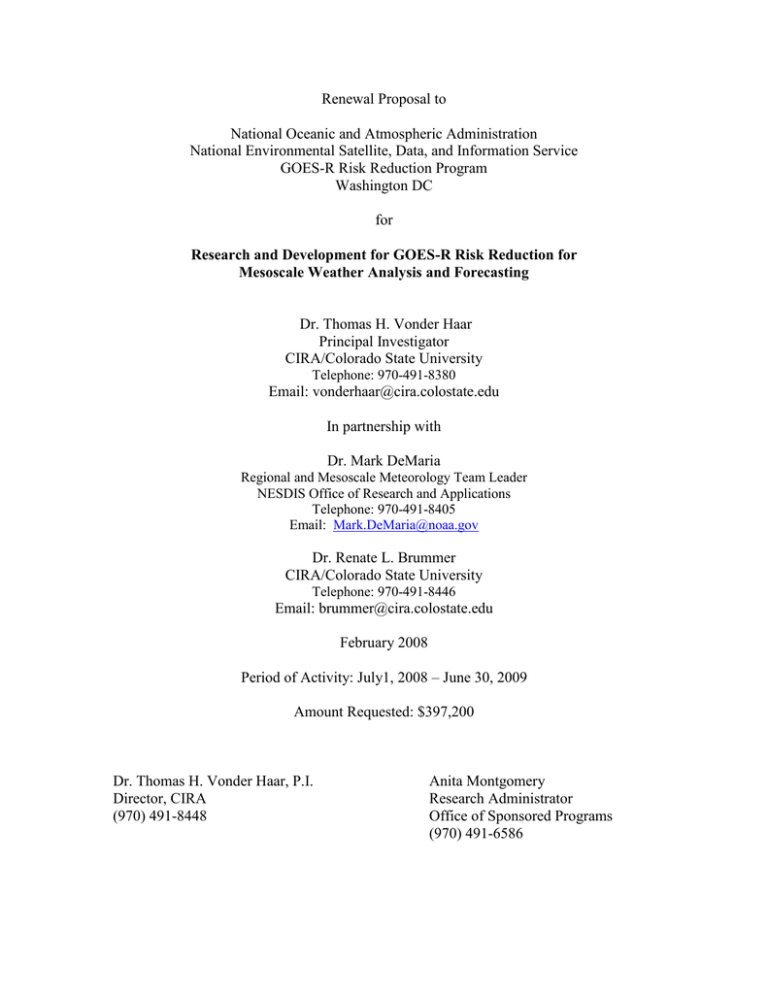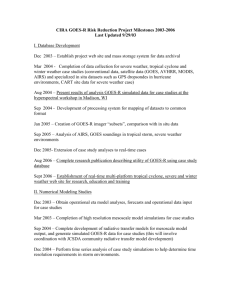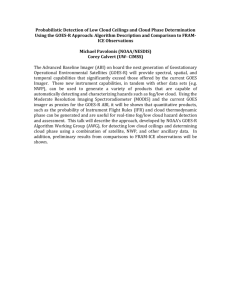Renewal Proposal to National Oceanic and Atmospheric Administration
advertisement

Renewal Proposal to National Oceanic and Atmospheric Administration National Environmental Satellite, Data, and Information Service GOES-R Risk Reduction Program Washington DC for Research and Development for GOES-R Risk Reduction for Mesoscale Weather Analysis and Forecasting Dr. Thomas H. Vonder Haar Principal Investigator CIRA/Colorado State University Telephone: 970-491-8380 Email: vonderhaar@cira.colostate.edu In partnership with Dr. Mark DeMaria Regional and Mesoscale Meteorology Team Leader NESDIS Office of Research and Applications Telephone: 970-491-8405 Email: Mark.DeMaria@noaa.gov Dr. Renate L. Brummer CIRA/Colorado State University Telephone: 970-491-8446 Email: brummer@cira.colostate.edu February 2008 Period of Activity: July1, 2008 – June 30, 2009 Amount Requested: $397,200 Dr. Thomas H. Vonder Haar, P.I. Director, CIRA (970) 491-8448 Anita Montgomery Research Administrator Office of Sponsored Programs (970) 491-6586 1. Introduction The next generation GOES satellites (beginning with GOES-R) will include the Advanced Baseline Imager (ABI) with vastly improved spectral, spatial and temporal resolution relative to the current GOES I-M series satellites. It will also include a lightning mapper which, together with the ABI, offers the potential to significantly improve the analysis and forecasts of tropical storms. The GOES-R era will begin early in the next decade, and will be part of a global observing system that includes polar orbiting satellites with comparable spatial and spectral resolution instrumentation. One of the advantages of GOES-R is the high temporal resolution that is possible from geostationary orbit. The emphasis of our proposal is on mesoscale atmospheric phenomena that evolve on time scales faster than that which can be sampled from polar orbiting satellites. These phenomena include tropical cyclones, severe weather and mesoscale aspects of winter weather, as well as the detection of atmospheric hazards such as fog, dust and volcanic ash. We also propose to perform data assimilation experiments in coordination with the Joint Center for Satellite Data Assimilation (JCSDA). In addition our GOES-R Risk Reduction contributions include a well-developed training component which is being coordinated with the Virtual Institute for Satellite Integration Training (VISIT) program and the Satellite Hydrology and Meteorology (SHyMet) Training Program. This science study will help to reduce the time needed to fully utilize GOES-R as soon as possible after launch. 2. Summary of Results from Past Years The emphasis of our earlier research was on the establishment of the dynamic web-based case study database and on the set up of a numerical cloud model and radiative transfer code. We began to produce synthetic GOES-R ABI imagery for several different mesoscale weather events. We studied the application of various difference products from combinations of the selected GOES-R channels. We applied the results from our case studies to experimental product development when possible using existing experimental and operational satellites. We put a lot of effort into making experimental real-time results available via the Internet. The emphasis of our assimilation experiments shifted from idealized experiments to those with real data. The Maximum Likelihood Ensemble Kalman Filter (MLEF) assimilation system has reached a mature stage and we began to include the WRF-NMM model into the data assimilation system. In addition we successfully started to develop prototype hazard products for fog and dust cases. A GOES-R ABI fog-stratus and blowing dust discrimination Red Green Blue (RGB) product was developed and published. We also conducted experimental work with image differencing, and Principal Components in combination with the RGB display. Much progress was also made with our tropical cyclone work. A large tropical cyclone proxy ABI dataset was collected using Meteosat Second Generation (MSG) satellite data. A preliminary analysis of ABI channels for storms from the 2006 hurricane season was completed and a hurricane eye sounding procedure was developed. 2 These and many more of the CIRA Team’s achievements are summarized in the detailed quarterly reports which we provide regularly to NOAA and which are available on-line at: http://rammb.cira.colostate.edu/intranet/ProposalReports/Previous%20Pages/pregoesr.html Our new proposal extends our previous work into new areas. This work is divided into six project areas including I. Data assimilation; II. Hazard studies; III. Severe Weather; IV. Training; V. Tropical Cyclones; and VI. Winter Weather. Further details are described below. 3. FY08 Projects Project I: Data Assimilation: Extracting Maximum Information from the GOES-R Data By extracting maximum information we expect to significantly improve the use of the GOES-R data. We also propose to test our methodology under the NCEP operational environment to provide the best possible operational readiness for the improved use of the GOES-R datasets. Proposed milestones: Develop algorithms for assimilation of band-averaged AIRS and/or MSG radiances similar to GOES-R ABI radiances. Employ other observations available at the NCEP operational data assimilation systems to be able to asses the impact of the AIRS data in the presence of other data. Project II: Hazards Studies with GOES-R Advanced Baseline Imager (ABI) Fire, volcanic ash and fog are hazards that frequently require rapid response. The high temporal resolution of GOES-R and its large number of channels allows for the development of essential hazard products. Proposed milestones: Fog-stratus and Blowing-dust Products – Collect and process data for online output and develop web display for feedback from potential users. Other New Products (volcanic ash, and smoke from fires, etc.) – Collect and process data and test product changes, as well as make the products available online. Create methodology for introduction of smoke and trace gas on current fire simulations. Project III: Severe Weather GOES-R ABI temporal sampling rate of 5 minutes and the 2 km footprint are well suited for severe weather applications. We are proposing to take advantage of existing software to generate synthetic GOES-R ABI imagery to support wind requests for severe weather, aviation requests for particle size, proxy data requests for data assimilation studies, and GOES-R AWG proxy data requests for Mesoscale Convective Systems (MCS). These proxy datasets will support the GOES-R algorithm development. Proposed milestones: 3 GOES-R Utilization—Collect satellite data. Acquire coefficients for ABI channels 1-6 from Joint Center for Satellite Data Assimilation (if available). Application to MCS—Collect case study data, Run simulation. Application to Severe thunderstorm—Run simulation. Begin analysis of sounder data in storm environment. Adapt PCI technique to synthetic data. Project IV: Training Our training proposal will leverage on and enhance existing training structure. The training will be provided through the VISIT and SHyMet programs. The objective is to ensure that the future GOES-R dataset user is well informed about the new capabilities and is capable of making decisions on the use of new GOES-R channels and products. Proposed milestone: Training module highlighting imagery and products for GOES-R Project V: GOES-R Applications to Tropical Cyclone Analysis and Forecasting It is known that the tropical cyclone intensity forecast skill still lags that of track forecasting. But unanticipated rapid intensity changes are a major problem for coastal evacuations. In addition TC genesis forecasting capabilities are very limited. We propose to test currently applied genesis and intensity forecasting procedures by using simulated high temporal and spatial GOES-R datasets. We also plan to evaluate predictive signal in lightning data. And we propose to conduct tropical cyclone structure analysis by generalizing GOES inner core wind algorithm to ABI channels and by creating storm structure analysis with proxy sounder data. Proposed milestones: Assemble proxy lightning mapper, ABI and sounding databases. Modify SHIPS, Rapid Intensity Index, TC genesis parameter to use GOES-R inputs. Test eye sounding technique on large sample of cases. Present preliminary results at AMS tropical conference. Project VI: Winter Weather Studies with GOES-R Virtually all wintertime, high-impact weather in the United States occurs in association with midlatitude cyclones. We are proposing to conduct enhanced tropospheric analyses (using COSMIC data) and to compare the potential vorticity fields to total ozone measurements from geostationary satellites. We are also proposing to construct a three year MSG winter cloud climatology dataset for analysis and algorithm comparison. Proposed milestones: Collect necessary geostationary and COSMIC data for a mid-latitude cyclone case study and begin developing the PV/Ozone technique. Total ozone from the current GOES sounder or Meteosat will be used. Pick test cases for cloud climatology and process data. Design new cloud algorithm and test. Produce cloud composites using new algorithm. 4 4. Longer Range Plans This proposal covers only FY08. We anticipate that this work will continue over the next several years as part of a longer-range science plan for GOES-R Risk Reduction for mesoscale weather. In the future we would like to begin with testing all of our experimental GOES-R mesoscale products based upon the latest results. We would also like to increase significantly the education and training activities in preparation for the launch of GOES-R. The numerical modeling studies will transition from the underlying CSU RAMS model to the Weather Research and Forecast (WRF) model when similar physical parameterizations become available. Our genesis and intensity forecasting procedures will become ready for real-time testing. In summary we propose to continue the development of GOES-R products in order minimize the time needed to fully utilize GOES-R as soon as possible after launch. 5. Project Personnel Project Oversight and management will be provided by Prof. Thomas Vonder Haar, Dr. Renate Brummer (CIRA/CSU) and Dr. Mark DeMaria (NESDIS/StAR). Scientific guidance will also be provided by Dr. James Purdom, a CIRA Senior Research Scientist, and former Director of the NESDIS Office of Resarch and Applications. The data assimilation studies will primarily be performed by Dr. Dusanka Zupanski and Dr. Louis Grasso, with oversight from Dr. Mark DeMaria. Dr. Dusanka is a CIRA employee who formerly worked for the NCEP Environmental Modeling Center, and is an expert on mesoscale modeling and data assimilation. Louis Grasso has extensive experience with the RAMS model, and is a former student of Dr. Bill Cotton, the original developer of RAMS. Dr. Don Hillger will be the leader of the new GOES-R ABI hazards study project. He will work closely together with Bernadette Connell and Dr. Manajit Sengupta. Technical support will be provided by Dave Watson and Hiro Gosden (CIRA research associates). The severe weather project will be headed by Dr. Louie Grasso, Daniel Lindsey and Dr. Manajit Sengupta with technical support provided by Hiro Gosden. M. Sengupta will lead the radiative transfer modeling activities within this research. Jack Dostalek will also contribute to this research. Oversight will be provided by Renate Brummer and Mark DeMaria. The training project will be headed by Dr. Bernadette Connell who has extensive experience in this area. She will be supported by Dan Bikos and Jeff Braun. Hiro Gosden will provide the technical training support. 5 Dr. John Knaff and Dr. Mark DeMaria will be leading the tropical cyclone analysis and forecasting project. M. DeMaria and John Knaff are NESDIS StAR employees with extensive background in tropical cyclone analysis and forecasting, and numerical weather prediction. Additional support for this project will come from Andrea Schumacher, Jack Dostalek, Renate Brummer, and Dave Watson. Cindy Combs and Jack Dostalek will lead the winter weather study project. They will be supported by Renate Brummer, Hiro Gosden, Dan Bikos and Jeff Braun. Kathy Fryer will provide administrative support. The project also will include student participation. The inclusion of students will help cultivate future scientists that have familiarity with the GOES-R program. 6. Project Coordination and Documentation This research is part of a larger GOES-R Risk Reduction program that is being coordinated with NESDIS/StAR and NESDIS/OSD. Quarterly progress reports will be provided to OSD and ORA management, and research results will be presented at annual activities reviews. 7. Budget Explanation I. PERSONNEL Salaries and benefits are requested for the personnel that will be performing this research, and providing computer support as described in section 5 above. In a basis consistent with our long-standing Memorandum of Understanding between NOAA and Colorado State University, the enclosed budget specifically includes support for administrative and clerical personnel (Fryer) directly associated with the technical and managerial administration of GIMPAP. This support is “quid pro quo” for the reduced indirect cost rate agreed upon in the long-standing subject memoranda. K. Fryer will provide communication and collaboration support, assist in the acquisition and distribution of reference materials relevant to the conception and execution of the project, technical editing of scientific manuscripts, specialized reports and conference papers. All other budgeted personnel are directly involved in the research which is identified in the Statement of Work (SOW). II. FRINGE Base salary included in this proposal reflects the actual salaries approved by the Governing Board of Colorado State University for the period July 1, 2007 through June 30, 2008. Any salary beyond this period is budgeted at a 5% increase over the prior year’s annual base. The following CSU fringe rates were applied to the salaries based on the individual’s payroll classification: a. Faculty/Administrative Professional FY 08-09 24.4% 6 III. TRAVEL Funds are requested for participation in scientific meetings and collaboration with other researchers. Per diem rates are applied to the destination location as listed in the CSU per diem/city publication. Standard mileage distances and rates are used for transportation to and from DIA from Fort Collins. Airfares are obtained from state approved travel agencies. IV. OTHER 1. The computer charges provide computer and data support associated with this project. The hourly rate is determined by CIRA and depends on the actual cost of network/printing, consultation, materials, and data. 2. The MUG fee is for the McIDAS software that is used extensively to analyze and display the satellite imagery. 3. The publication charges are to publish results from this project in scientific journals. V. MATERIALS AND SUPPLIES A small number of DVDs are needed for data archive. VI. EQUIPMENT This project will require an additional PC and some commercial off the shelf software for data analysis. VII. INDIRECT COST RATE The Indirect Rate of 25% charged on this proposal is the negotiated rate for CIRA’s Cooperative Agreement from January 1, 2005-June 30, 2009. The rate is applied to Modified Total Direct Costs (MTDC). MTDC is defined as Total Direct Costs less Equipment, GRA Tuition, and Subcontracts > $25,000. 7


